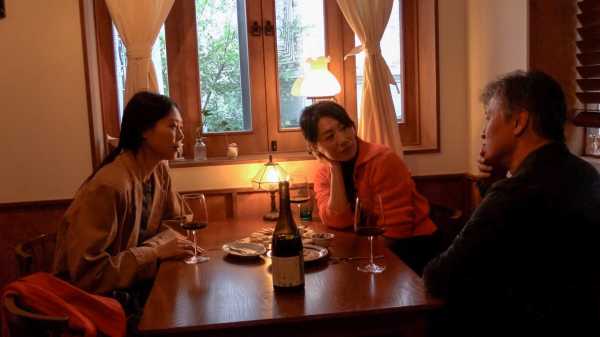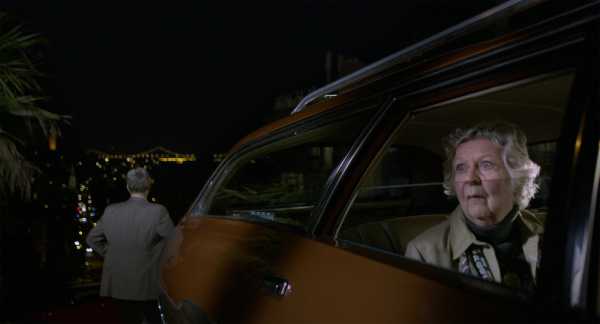
Save this storySave this storySave this storySave this story
The New York Film Festival, like all worthwhile festivals, regularly offers the joyous surprise of distinctive new artistic voices, whether those of filmmakers who are just starting out or ones whose previous work hasn’t been released in the United States. But a defining trait of the already recognized greats on its roster is that, despite the apparent familiarity of their styles and ideas, their new films inevitably deliver similarly thrilling surprises that expand both their artistic scope and the possibilities of the art.
So it is this year. All but one of the filmmakers whose new work I recommend here are veterans of the festival. Their new movies are nonetheless startling, and it’s exemplary of the self-challenging art of Paul Schrader that his entry, “Oh, Canada,” offers the sharpest shock of all—the boldest divergence from his earlier work, the keenest sense of an aesthetic leap forward. Oddly enough, though Schrader has been directing movies since 1978 (starting with the fierce melodrama “Blue Collar”), he first appeared at the festival only in 2002, with “Auto Focus.” It’s a grimly fascinating thought experiment to imagine which new movies that don’t figure in the festival will be remembered, decades hence, as overlooked classics (as Rungano Nyoni’s earlier feature, “I Am Not A Witch,” from 2017, which didn’t play at the N.Y.F.F., will surely be). But it’s also a cheering one to look at extraordinary movies by this year’s festival newcomers (starting with RaMell Ross, whose first dramatic feature, “Nickel Boys,” was the opening-night offering) and anticipate exactly what defies anticipation—their films to come.
“Oh, Canada”
Paul Schrader’s resurgence in recent years has also been a resurgence of the rage that drove most of his classic movies of the nineteen-seventies and eighties, and with his new film, “Oh, Canada” (Oct. 5-6 and Oct. 9), his rage is aimed at the ultimate target: death. Most of Schrader’s films feel personal, but this one hits unusually close to home: it’s a film about filmmakers and a drama of the making of a film. It’s also personal in another regard—it marks Schrader’s reunion with an actor who’s closely identified with one of his films, Richard Gere, the star of Schrader’s 1980 film, “American Gigolo.” In “Oh, Canada”—which is adapted from a novel by the late Russell Banks—Gere plays Leo Fife, a celebrated documentary filmmaker in Montreal who is dying of cancer. Two of Leo’s former students have come to his house to film an interview with him—essentially an exit interview from life. Leo’s one condition is that his wife, Emma (Uma Thurman), be present the entire time, because he intends the talk to be a last-chance confession, to her—even as she cautions him that not he, but the filmmakers, will control the results.
The interview is centered on reminiscences of the start of Leo’s adult life. Born and raised in Massachusetts, Leo forged his destiny and made his reputation, in 1968, in his mid-twenties, by fleeing to Canada as a draft evader. “Oh, Canada” is a memory-movie, and Schrader interweaves the present and the past with free-spirited and form-shifting audacity, in scenes that feature Jacob Elordi as Leo’s younger self, and in scenes that, joltingly and movingly, insert Gere, as old Leo, into the youthful protagonist’s life. Leo seems to savor revisiting his youth even as he fights to unburden himself of his sins and failings—because, in a way, he gets spiritual and moral satisfaction from his overt self-flagellation.
“Oh, Canada” details the young Leo’s precociously accelerated emotional rise and fall: an aspiring writer who was planning a life of adventure, he was, by the age of twenty-two, a paterfamilias, having married a woman of a higher social station and higher social expectations and fathered a child who needed to be provided for on an academic’s starting salary. Schrader details Leo’s relationships with other women before and during that marriage, his contentious friendships, his failed plans and broken dreams, his impulsive life-changing decisions. As Schrader ardently reconstructs the politics, the mores, the social conflicts, and the styles of the Vietnam War era, he looks, with an implicitly self-scourging fury, at youthful missteps, misdeeds, and missed opportunities. His film confronts the stories that one tells, which crystallize into one’s own fabricated identities—solid façades that are shattered by the power of his direction.

Photograph courtesy A24
“On Becoming a Guinea Fowl”
The enigmatic title of the Zambian-Welsh director Rungano Nyoni’s second feature, “On Becoming a Guinea Fowl” (Oct. 3, Oct. 5, and Oct. 11), gets a searing clarification at the end. For that matter, the entire drama is set up as a mystery and, as its details unfold, agonies that have remained long hidden are brought to light. A young woman named Shula (Susan Chardy), while driving a fine car by night on a lonely road, sees a body on the pavement and, getting out for a closer look, realizes that the dead man is her Uncle Fred. During the ensuing days of family gatherings and funeral rites, the secrets of Fred’s life as a serial sexual abuser—and the stories of his victims—emerge.
Take note of faces and of when they’re not seen. As something of an outsider, Shula (who lives in another country and has only just returned to Zambia) participates in the family’s traditions while keenly discerning their enforcement of patriarchal power, which includes codes of silence. (Nyoni was born in Zambia and raised in Great Britain; the name Shula means “uprooted,” and was also given to the protagonist of “I Am Not a Witch.”) In learning the extent of Fred’s predatory ways and witnessing their destructive effects, Shula struggles to give voice to her own memories—and this is where Nyoni’s tense and canny compositions, freeing anguished confessions from melodrama and transferring the source of liberated speech to the body, lend this passionately turbulent and finely detailed drama mighty symbolic force.

Photograph courtesy The Cinema Guild
“By the Stream”
The second film by Hong Sangsoo playing in this year’s festival (the other is “A Traveler’s Needs”), “By the Stream” (Oct. 4 and Oct. 11) is modestly grand and serenely mysterious. With his distinctive sense of form, Hong is one of the most original filmmakers currently working, yet what makes his work so unusual is itself somewhat enigmatic. His movies tend to be straightforwardly realistic, but their relatively simple stories are composed of surprisingly oblique incidents. Most of his scenes are long and centered on dialogue, but their subjects touch the narrative framework only at a few nodal points. From wisps of activity, elaborate skeins of experience arise. Though Hong’s dramas are direct and concrete, his ideas about drama are abstract and quasi-musical. (That’s why summaries of them hardly convey the experience of watching them.) “By the Stream,” which is among the most expansive and extensive of his recent films, is energized by a peculiar sort of centrifugal force. At a women’s university, a young professor named Jeonim (Kim Minhee) calls upon her uncle, Chu Sieon (Kwon Haehyo), a former actor and director who now runs a bookstore, and from whom she has been estranged for years. She wants him to write and direct a skit to be performed by her students, in lieu of a male student who’d written one but was sent away for starting relationships with three of the young women involved in the project.
The crisscrossing connections that arise during Chu Sieon’s visit involve the rekindling of his relationship with his niece and the forming of a new one with one of her colleagues, Jeong (Cho Yunhee), an older professor and a longtime fan of his. Past troubles, both professional and political, loom large over these relationships, and over the art world in which they’re set. (Even the skit—merely of four women merely sitting, eating, and talking—evokes a momentous and controversial situation.) The tale—which involves eating and drinking in local restaurants and cafés, and savoring the sensual pleasures of cuisine and of conversation alike—is expanded by the lure of distant places and the effect of changes of scenery on emotional temperature, of travel plans on emotional bonds. The artists at the core of the story display their refined sensibilities in action—by their poetically personal ways of teaching, the delicacy of their personal relationships, their sense of principle, their candor, their open-mindedness. Hong’s characters deliver sharp dialogue that blends piercing confessions and resonant aphorisms, and his lyrical cinematography, encompassing many sequences of nature (including scenes indeed set by the stream), makes all the world their stage.

Photograph courtesy Suburban Fury
“Suburban Fury”
To the list of great documentaries rooted in interviews of a single person, such as Shirley Clarke’s “Portrait of Jason” and Jean Eustache’s “Numéro Zéro,” add Robinson Devor’s “Suburban Fury” (Oct. 9-10 and Oct. 13). The film is constructed from extended interviews with Sara Jane Moore, who, in San Francisco, in 1975, shot at then-President Gerald Ford (who was unharmed). She was arrested, pled guilty to attempted assassination, was imprisoned, and was released in 2007. (Moore currently lives in Tennessee.) Soon after her release, Devor interviewed Moore, under circumstances that turn what could have been a talking head into a character in a living drama: he filmed the discussions on location, often from inside a car, at places that figure in her story, and also in a hotel ballroom where she was interrogated and a house where she once lived. Moreover, the terms that Moore set for Devor’s interviews decisively shape the film: she requested that no other person be interviewed for it. Thus, in order to contextualize Moore’s accounts of her actions, her observations, and her states of mind, Devor assembles an extraordinary array of archival film clips, mainly from the nineteen-seventies, which evoke individuals and events that played a direct role in her plans and shaped her point of view.
The specifics of Moore’s story—both as she tells it and as Devor’s record of archival documents attests—are extraordinary, yet, at times, slippery. The film reports that she was married and divorced four times and had five children, one of whom she raised, while her mother raised the others. She had made attempts at an acting career, and later turned to radical politics, joining groups including the Symbionese Liberation Army, which had kidnapped Patty Hearst in 1974. Eventually, she was recruited as an F.B.I. informant, and delivered information on these groups in order to disrupt their activities, even as she took part in them (procuring guns from a neighbor who was on the far right,) and sympathized with their members’ goals. Her emotional life was tightly bound up with her covert work and her revolutionary affiliations alike, and, even as she was denounced in leftist circles as a spy, she sought to spark a revolution. (In voice-over, Devor sometimes plays the role of Moore’s F.B.I. handler, but this character is fictional—and, dubiously, Devor doesn’t say so in the film.) Ultimately, the loose threads of Moore’s life story suggest the elusiveness of identity itself, the many guises and roles, affinities and ambitions, frustrated plans and contradictory goals of which a life is made—and the uncanny connections of intimate motives to the grand currents of history. ♦
Sourse: newyorker.com